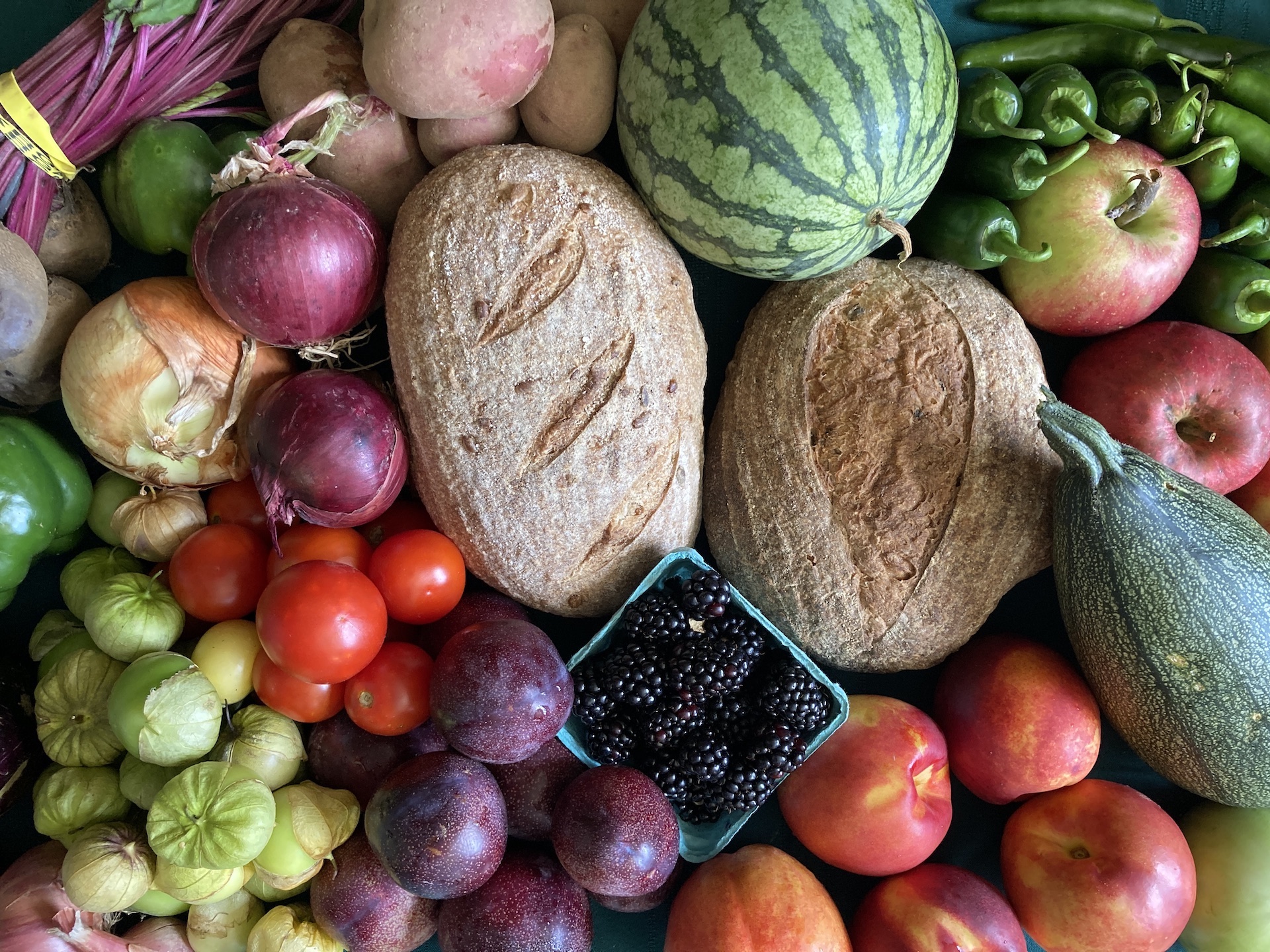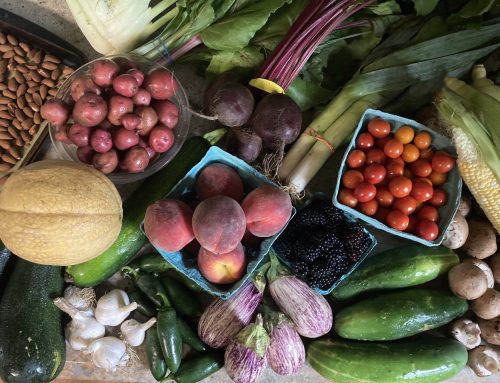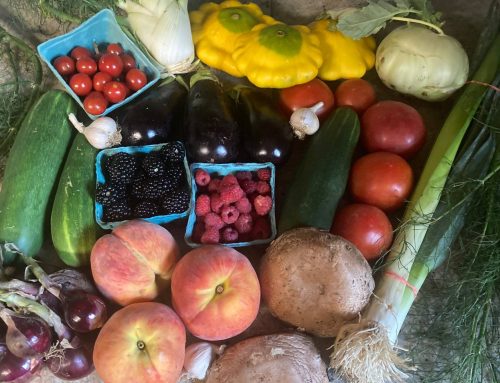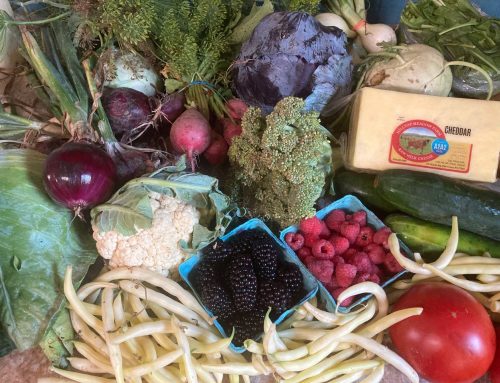Veggies We Harvested This Week: Aug. 22, 2023
Every member’s customized Market Box is unique so we hope you will take advantage more varieties of vegetables as you get comfortable with all the great organic produce we are offering. Use our A to Z Vegetable Guide to help use and store your veggies. Storage tips and NEW RECIPES below.
Storage & Usage Tips
I share new information about
- shallots vs. onions
- our onion crop
- sourdough bread for gluten free folks
- difficulties of growing organic fruit in our area
- pickling garlic and nutritional benefits
Coming Soon: Yellow Beans. We expect to be able to offer winter squash and sweet colored peppers in the coming few weeks. Spaghetti Squash is usually first. If you want those the first time they are offered, make sure they are rated 5 in your preferences and there aren’t too many other competing 5s.
What to use first: eggplant, tomatoes, microgreens, blackberries,
Finished for the season: Asparagus, basil, garlic scapes, snap peas, chamomile, rhubarb, scallions, tomatillos
Done for now but will return: Broccoli, Bok choy, Radish, Cabbage, Napa Cabbage, Collards, Kale, Kohlrabi, Greens Beans
Beets, red – If greens are attached to the beets, cut the stems two inches about the beet root bulb. Store greens separately. Use beet greens first, within one or two days. One way to use my Feta cheese would be in this dish: NEW RECIPE: Beet Fries
Cucumber, Slicing – store in a loosely sealed plastic bag in the fridge. NEW RECIPE: This Balkan Cucumber Salad uses honey, yogurt, red onions, herbs and walnuts. I love Tzatziki Sauce and I did finally make it this week.
Eggplant can be left unrefrigerated at a cool room temperature for a day or two or in the crisper drawer for one week but it tastes best when used soon after picking. Eggplant can be peeled or unpeeled depending on the type of dish you are preparing.Just like a zucchini doesn’t have much flavor on its own so it’s often paired with other veggies in a dish, so, too, the eggplant is often paired with other stronger flavors. It can be sauteed, baked, fried, grilled, or steamed. Have you checked out my blog post for FIVE EASY STRATEGIES FOR PREVENTING EGGPLANT OVERLOAD? NEW RECIPE: Curried Eggplant is one I’ve made a couple times recently.
Salting & Draining Eggplant – It’s a good idea, if time allows, to salt the sliced or chopped eggplant and soak in water for about 15 minutes and then gently drain and squeeze to get rid of acrid flavors according to From Asparagus to Zucchini cookbook.
Eggplant, Japanese – slender varieties of many color variations of purple and white, see pictures above. Lends well to sliced circles.
Eggplant, Purple – Italian globe variety lends itself to stuffing, slicing, cubing and roasting. You can freeze eggplant when it is cooked in a dish like ratatouille or baba ghanouj, and enjoy the classic eggplant parmesan or pick from these 8 simple ways to cook eggplant.
Garlic – should be kept in a cool, dry place. All our garlic is now cured so it can be stored in a cool, dark, dry place for several months. Use in any recipe and add peeled cloves to pickles. In the video I showed you my jar of Fermented Pickled Garlic. Use the Fermented Pickles Guide to make the brine and pour over your peeled garlic. Use them to easily add garlic to salads, dressings, sauces, dips or any dish that calls for garlic. To use medicinally, slice or crush and eat raw with food (a slice of bread) or drink down with a bit of water.
Green Beans – (Should return soon.) Beans should be stored in a loosely sealed plastic bag for about a week in the crisper drawer. I never get tired of fresh green beans. Have you used your beans in a cold salad yet? *NEW* Roasted French Bean Salad with Pine Nuts and Parmesan or See this post for Freezing Fresh Beans.
Lettuce, Romaine – Store your lettuce properly and enjoy summer salads with sliced vegetables from your box.
Microgreens – Refrigerate immediately. Keep bag sealed. Fold down to remove most air. Put in coldest part of refrigerator. Often, a bottom shelf. Can be frozen to add later to soups and other meals. Check out Emanuel Farm Powdered Microgreens for longer term shelf life. They are a tasty, nutrient-rich boost for shakes, smoothies and meals and a great seasoning for adding flavor to dishes and dips. All our micro greens are from Emanuel Farms.
Onion, red – are finally here! I’ve been looking forward to these fresh, colorful onions. Use them in raw salads and salsas. They not for long term storage, so keep them in the fridge for up to a few weeks. Download the Onion Guide – see below. Here is a Corn Salad recipe that uses your red onion too. NEW RECIPE: Grillied Summer Squash with Red Onion & Feta
Peppers – are a popular and versatile vegetable that comes in various colors, including green, red, yellow, orange, and even purple. They belong to the nightshade family and have a mildly sweet flavor with a crisp texture. Peppers are low in calories and fat but rich in vitamins and minerals. They are particularly high in vitamin C, providing more than 100% of the recommended daily intake per serving. Peppers also contain vitamin A, vitamin B6, dietary fiber, and antioxidants, such as carotenoids and flavonoids, which contribute to their vibrant colors and potential health benefits.
Storage for all peppers: keep them dry and refrigerated in a perforated plastic bag for up to one to two weeks. Avoid storing them with fruits or vegetables that emit ethylene gas, as this can cause them to spoil faster.
Usage: Peppers can be used raw in salads or as a crunchy snack, and they are excellent for stir-fries, sautés, soups, stuffed dishes, or grilled kebabs, adding flavor and nutrition to various meals. Their different colors can also add an appealing visual touch to your dishes.
Green Bell Peppers– Green peppers pack the most nutritious punch when eaten raw. Try on salads, sandwiches, or dipped into a favorite dip. Cooked, green pepper can be used in soups, chili, casseroles, egg dishes, or stir-fries. Can be sliced, diced and frozen for later cooked dishes. Pepper & Chicken Stir Fry Recipe or Fresh Garden Soup
Hungarian Wax – also known as hot wax peppers or hot banana peppers, are elongated chili peppers originating from Hungary. They have a mildly spicy flavor, ranging from mild to moderately hot, and are commonly used in cooking and pickling due to their versatility and unique taste. Nutritionally, Hungarian wax peppers have the added health benefits from the compound capsaicin.
Usage: Hungarian wax peppers can be used raw in salads, sandwiches, or as a zesty garnish for tacos and burgers. For cooking, try sautéing, grilling, roasting, or stuffing them with fillings like cheese, rice, or seasoned meats. Incorporate these peppers into sauces, soups, stews, or stir-fries for added depth and heat to your dishes.Consider pickling any excess peppers for prolonged enjoyment of their tangy flavor.
Heat Index: The heat level of Hungarian wax peppers can vary from mild to moderately hot, depending on their ripeness and individual variation. Pale yellow peppers tend to be milder, while fully ripe red peppers may have more significant heat. Taste a small piece before use to gauge spiciness and adjust according to your preference.
Jalapeño – a popular variety of chili peppers with a distinctive bright green or red color when fully ripe. They are low in calories and fat while providing a good amount of vitamins A and C, as well as potassium and dietary fiber. They also contain capsaicin, the compound responsible for their spiciness, which is known for its potential health benefits, such as pain relief and metabolism-boosting properties.
Usage: Jalapeño peppers are commonly used raw in salsas, guacamole, and as a topping for tacos, nachos, pizza and other dishes. When cooked, jalapeños add a bold kick to soups, stews, sauces, and stir-fries. They can also be roasted, stuffed, or incorporated into marinades for meats and vegetables, offering a depth of flavor and heat.
Heat Index: Jalapeño peppers are known for their moderate to high heat level, typically ranging from 2,500 to 8,000 Scoville Heat Units (SHU). The level of spiciness can vary depending on factors such as ripeness and the specific pepper’s genetics. IMPORTANT: USE GLOVES! Be cautious when handling jalapeños (at least if you are handling more than a few at a time or are sensitive), as their seeds and membranes contain the most capsaicin and can intensify the heat. Remove these parts if you prefer a milder flavor or keep them for a spicier kick.
Serrano – are hot chili peppers widely used in Mexican and Latin American cuisines. They are smaller and narrower than jalapeño peppers, with a bright green or red color when fully ripe.
Usage: Serrano peppers are a staple in many spicy dishes. They can be used raw in salsas, guacamole, or as a garnish for tacos, enchiladas, and other Mexican dishes, adding a bold kick to the flavors. When cooked, serrano peppers infuse stews, sauces, soups, and stir-fries with their fiery heat and rich flavor. They can be roasted, grilled, or charred to enhance their taste and used in marinades for meats and vegetables.
Heat Index: Serrano peppers have a Scoville Heat Unit (SHU) ranging from 10,000 to 23,000, making them hotter than jalapeños but milder than some other chili peppers like habaneros or ghost peppers. USE CAUTION! USE GLOVES! Many an american cook has thought, “these don’t bother my skin”, until they can’t sleep at night because of the burning sensation.
Fermented Pickle Peppers – I use the same method to Pickle Ferment Hot Peppers. Use the Fermented Pickles Guide to make the brine and pour over your sliced hot peppers. Use them to easily add hot peppers to salads, sandwhiches, pizza, tacos, burritos, dressings, sauces, dips or any dish that calls for heat.
Potato, Red skinned – a type of potato of boiling potato with a bright red or pink skin and a creamy, white flesh. They have a subtly sweet and buttery flavor and are known for their smooth texture, making them versatile for various culinary uses. Nutritionally, red-skinned potatoes are a good source of vitamins and minerals, including vitamin C, potassium, and dietary fiber. They also provide antioxidants, such as anthocyanins, which contribute to their vibrant color and potential health benefits.
Storage: To store red-skinned potatoes, keep them in a cool, dark place with good ventilation, such as a pantry or cellar. Avoid storing them in the refrigerator, as the cold temperature can cause the starches to convert to sugar and affect their taste and texture. Properly stored, red-skinned potatoes can last for several weeks.
Usage: Red-skinned potatoes have a waxy texture, which means they hold their shape well when cooked. An excellent choice for boiling, steaming, and using in salads, stews, gratins and soups. Because they maintain their firmness and shape, they don’t become overly mushy after cooking. Their thin skin adds a delightful color contrast and texture to dishes, making them a popular choice for potato salads. Their slightly sweet flavor pairs well with herbs and spices, making them a delightful addition to a range of recipes. RECIPES: These are the perfect potatoes for using your favorite oven roasted recipe like Roasted Red Skinned Potatoes & Onion, Garlic Roasted Red Potatoes, Garlic Parmesan Roasted Potatoes . The first potato dish of the season that I make for the family is Buttery Parsley Potatoes.
Shallots are part of the onion family, often “bunching onions,” and milder, sweeter more elongated than onions. Store them Replace onions in recipes and especially good used raw in salads, dressings and sauces. Here are two great Shallot Recipes: Hakka Sauce and Crispy Shallots in a Grain Bowl
Sweet Corn – To prepare sweet corn, peel off husks and silk. Boil in water for 5 – 8 minutes and serve hot with plenty of good butter and salt. You can eat corn raw or cook it in the oven or grill with the husks on (usually after soaking them in water.) . Shuck the cob by pulling the husks down the ear and snapping off the stem. The silks will fall off as you cook the corn. Rinse under cold water. If you see a worm in the tip, just cut out the damaged section — the rest of the cob is still edible! To cut the kernels off the cob, stand the cob upright on its base and run a sharp knife from the tip of the ear down to the base. Save those used cobs for making broth!You can store sweet corn in the fridge for a day or two but you should eat it soon for the best flavor. Need recipes? 30 Sweet Corn Recipes. I love making Mexican Elote with sweet corn. Here is a Corn Salad recipe that uses your red onion too.
Summer Squash– Our friend, Dennis, of Rising Son Farm, grew these Lebanese Summer Squash using only organic methods. Use as any summer squash but enjoy the light green striped skin and squat shape. It’s a great shape for stuffing as it is shorter and rounder. The traditional Lebanese Stuffed Squash dish is called Kousa. I’m sure each family has its own variation on the recipe but you can start with this recipe. I’d love to have your recipe if you have a family recipe for Kousa.
Tomato, Red – Keep tomatoes stem side down on the counter at room temperature. Tomatoes should not be refrigerated. Use within a week. Tomatoes are high ethylene producers, which means they will cause other produce to ripen quickly (or spoil quickly) if placed nearby. So be careful what you store next to tomatoes. Use a very sharp, serrated knife to cut them. Try Fresh Tomato Soup, with variations. These Simple and Reliable Tomato Recipes include Fresh Pasta Sauce, Gazpacho, Caprese Salad.
Tomato, Medium – This size of tomato is about the size of a golf ball. Use like a large cherry tomato.
Tomato, Cherry – Store on the counter; do not refrigerate. Snack or use in salad, frittata or pizza. RECIPE: Green Bean and Cherry Tomato Salad or Grilled Eggplant, Grape Tomato, and Feta Salad
Tomato, Paste – are medium oval-shaped tomatoes with a more mealy texture and less juice. Roma or Plum tomatoes are well known types of paste tomatoes but we also grow large, meaty Amish Paste tomatoes. Best for making sauce, oven-drying (because of their lack of moisture), or for stewing.
Tomato, Seconds – “Seconds” is the word used for “second quality” produce. It may have a blemish, bruise, or weird shape that prevents is from being considered “First Quality”. Instead of discarding seconds, they can be used to make something: tomato sauce, salsa, tomato soup, etc. Spots can be removed with a knife and experienced cooks know they can save money by buy “seconds” in bulk.
Farm Food Highlights
FRUIT:
Willow Haven Farm Apples – A sweet, crisp eating apple with a wonderful flavor. Farmer Reuben planted these trees on the farm years ago and can’t remember the name of the variety but loves the flavor. Our first significant harvest of these Certified Organic apples is due to the super dry spring which prevented diseases from taking hold. Storage: Extend the shelf life of apples by refrigerating them in the crisper drawer for a few weeks. Keep them separate from other produce to prevent accelerated ripening due to ethylene gas release. Usage: These versatile apples can be enjoyed fresh, sliced into salads for added crunch, or used in cooking and baking. Their firm texture holds up well in pies, tarts, and sauces, contributing a balanced sweetness to both sweet and savory dishes.
Nectarines – A fuzz-free cousin of the peach, use the same techniques to enjoy them. Keep ripe nectarines on the counter in a cool, dry place for a few days. They will ripen more as time goes on, so don’t keep your nectarines too long, since overripe stone fruit becomes mushy. You can also place the ripe fruit in the fridge to prolong its life, but nectarines taste best at room temperature. Sliced fruit should always be kept in the fridge in a sealed container, or you can freeze and store them in freezer bags or ice-proof containers for later use in baked goods or smoothies.
Yellow Watermelon – Watermelons store best out of the refrigerator for up to a few days, and you can chill them right before you want to eat them. Prolonged exposure to cold temperatures will cause the flesh to become mushy, but once you cut into the melon, it must be refrigerated immediately. Cut melon will only last a day or two in the fridge. If you don’t want to eat all your watermelon fresh off the rind, try this Watermelon, Tomato with Feta Salad.
Yellow Peaches – a variety of peaches with a golden-yellow skin and a juicy, sweet flavor. They belong to the Rosaceae family and are closely related to nectarines. Yellow peaches are a good source of potassium, vitamin A and C, dietary fiber, and antioxidants like beta-carotene.
To store peaches, keep them at room temperature until they reach the desired ripeness. Once ripe, they can be stored in the refrigerator to prolong their freshness. Place them in a plastic bag or container and store them in the refrigerator’s crisper drawer. Properly stored, donut peaches can last for up to five days.
See post: How Long to Fresh Peaches Keep?
Blackberries – a special treat that you’ll probably want to eat these fresh and natural – they are so good! Also use to top yogurt, frosted cakes, cheesecakes, anything chocolate, etc.
This Vinegar Rinse is highly recommended for Blackberries & Raspberries: mix one part vinegar with three parts water, then gently rinse the berries in the solution. Rinse them again with plain water and pat them dry before consuming or storing.
Our members are cooking…
Farm members are sharing recipes and photos of their delicious meals on our Member Only Chat Group. Use the link in the email you received from me today.
Zucchini Fritters with Sweet Corn on the side
Chicken Pinto Bean Enchilada with Creamy Salsa Verde
Puff Pastry Pizza with Farm Veggies and Grass Fed Cheese
Veggie E-Books
Download these collections of tips and recipes for each veggie. You’ll use these as a reference throughout the season.
Fermented Pickles Guide
Sweet Corn E-book
6 Types of Onions and How to Use Them
Don’t Miss Your Farm Events:
Harvest of Wisdom Homesteading Conference at Willow Haven Farm
Saturday, September 2. 8 am – 3 pm.
- morning and afternoon workshops with breakfast and lunch
- hands on workshops
- sourdough bread baking – limit 12 participants
- home cheese making – limit 12 participants
- chicken butchering
- food preservation – perhaps curing meat
- foraging herbs walk with “make and take”
- in depth farm tours with Farmer Reuben
- organic systems for vegetable growing
- organic systems for pastured dairy animals
Limited space. Must register for high demand workshops.
Open Gate Farm Tour
Saturday & Sunday, Oct 14 & 15. 1 pm – 5 pm.
Market Box Value!
Five of our Top Tips to get the most value out of your Market Box and enjoy the most food you’ll love. Read Here.
Your List of What to Return:
Please return the packaging we sent you for your last delivery. Here’s how and what exactly we’ll take back: Read Here.
We’ll Keep Farming for You!




